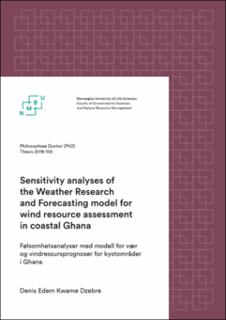| dc.contributor.advisor | Adaramola, Muyiwa Samuel | |
| dc.contributor.advisor | Ampofo, Joshua | |
| dc.contributor.advisor | Acheampong, Akwasi Afrifa | |
| dc.contributor.author | Dzebre, Denis Edem Kwame | |
| dc.coverage.spatial | Ghana | en_US |
| dc.date.accessioned | 2020-08-11T09:02:30Z | |
| dc.date.available | 2020-08-11T09:02:30Z | |
| dc.date.issued | 2019 | |
| dc.identifier.isbn | 978-82-575-1676-5 | |
| dc.identifier.issn | 1894-6402 | |
| dc.identifier.uri | https://hdl.handle.net/11250/2671427 | |
| dc.description.abstract | With the rise of modern wind turbines, wind energy has grown to become a major source of generated electricity, alongside other renewable and conventional energy sources. The geographical and time dependent nature of wind warrants detailed assessments to judge the feasibility of power projects. Pre-feasibility studies play crucial roles in this assessment process and include the performing of large area screening of feasible wind power project sites, designing of effective mast measurement campaigns and feasibility assessments of projects. A source of data for such assessments that has increasingly become popular over the years, is downscaled meteorological datasets which are sometimes produced with Numerical Weather Prediction (NWP) models. Due to uncertainties (from several sources) associated with the outputs of NWP models, their validation is an important step towards their optimization and application for desired purposes. Wind varies geographically. Therefore, the validation of NWP models is an important step towards their application for wind data downscaling for a geographic location.
Though studies have suggested that wind projects are feasible in Ghana, development of the resource still suffers from several challenges, including inadequate resource assessments. This thesis focuses on the application-oriented use of the Mesoscale Weather Research and Forecasting (WRF) model for wind prediction applications in the coast of Ghana and neighboring countries in the West African sub-region.
A local sensitivity assessment of selected numerical options (simulation length or run time and methods of applying the WRF model’s Four-Dimensional Data Assimilation (FDDA) nudging technique), as well as selected terrestrial and meteorological datasets on downscaled wind data for coastal Ghana were conducted. Validation of the simulations was done with statistical error metrics from prediction-observation comparisons. The error metrics were compared with performance benchmarks for wind prediction by NWP models that have been reported in scientific literature. In addition, Weibull distribution parameters, as well as probability and cumulative density functions of measured and predicted data were also compared.
Results of this thesis were communicated in four Papers. Paper I sought to deepen the understanding of the impacts of combining varying simulation run time and selected options in the method of applying the WRF model’s FDDA nudging technique for wind simulations. It was found that the method of applying nudging above levels automatically determined by the WRF model has a more consistent impact on model predictions. Paper II and Paper III assessed the impacts of Planetary Boundary Layer (PBL) and Surface Layer (SL) parameterization schemes on predictions from the model. It was concluded that the Turbulent Kinetic Energy (TKE) Mellor–Yamada Nakanishi Niino Level 3 (MYNN3) PBL scheme often had relatively better impact on downscaled data, when paired with the Eta SL scheme for simulations. On the terrestrial datasets, it was found that the two global Land Use and Land Cover (LULC) datasets available in the WRF Geographical Data did not differ significantly in their impact on downscaled data. In addition, among the Gridded Binary (GRIB) meteorological datasets available in the National Center for Atmospheric Research Data Archives, it was realized that the data assimilation systems used in producing these datasets is probably a good criterion for their selection for downscaling for the study area. The findings of this study were reported in Paper IV.
Results of a simulation covering a year with a model configuration based on the findings of the four papers showed that the model is capable of downscaling wind data with error metrics that can meet most of the performance benchmarks that have been reported in literature. The results from this final evaluation also suggest that the configuration established from the studies is probably suitable for offshore assessments in the area but will require further verification. | en_US |
| dc.language.iso | eng | en_US |
| dc.publisher | Norwegian University of Life Sciences, Ås | en_US |
| dc.relation.ispartofseries | PhD Thesis;2019:105 | |
| dc.rights | Attribution-NonCommercial-NoDerivatives 4.0 Internasjonal | * |
| dc.rights.uri | http://creativecommons.org/licenses/by-nc-nd/4.0/deed.no | * |
| dc.title | Sensitivity analyses of the weather research and forecasting model for wind resource assessment in coastal Ghana | en_US |
| dc.title.alternative | Følsomhetsanalyser med modell for vær og vindressursprognoser for kystområder i Ghana | en_US |
| dc.type | Doctoral thesis | en_US |

